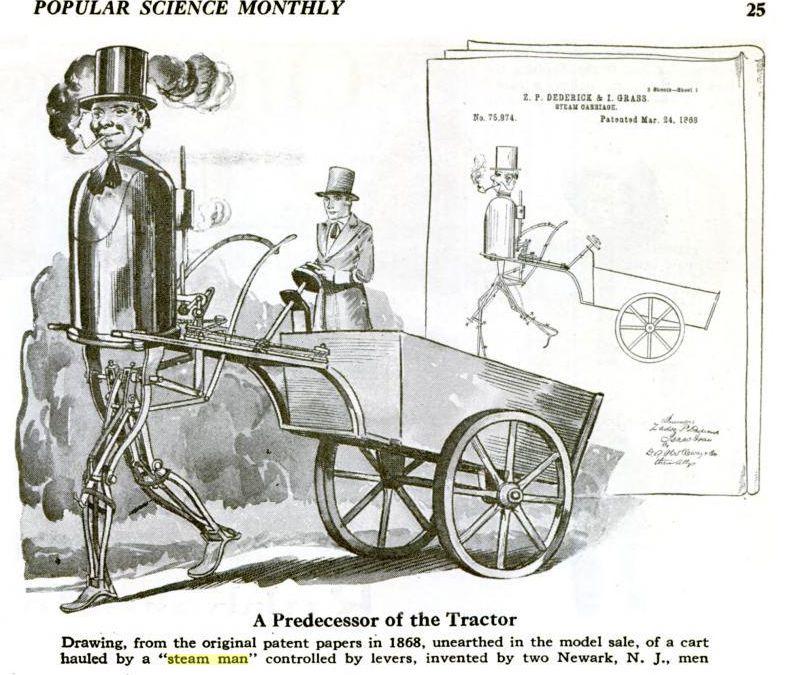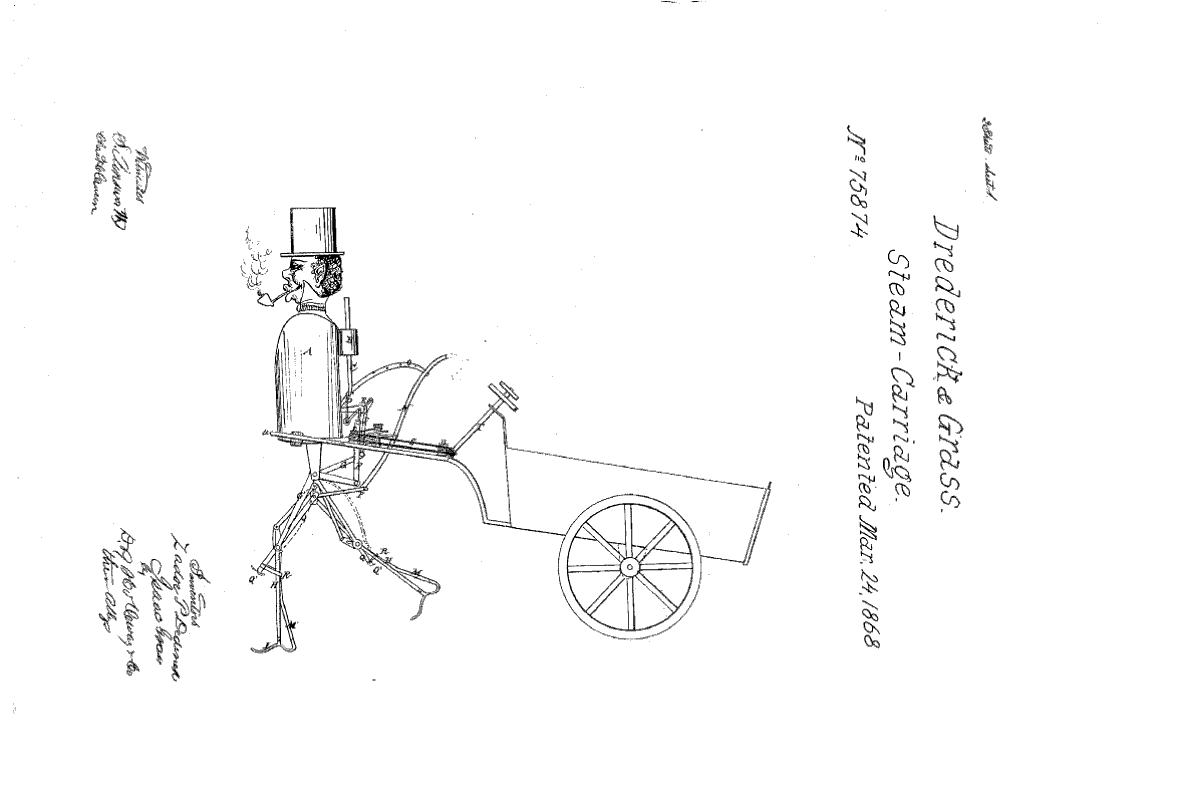**Zadoc Pratt Dederick** (age ~22 in 1868) was a Newark machinist/inventor who, with **Isaac Grass** (a teenage shop hand), built a human-shaped steam traction machine popularly dubbed the Steam Man of Newark. They patented the mechanism in 1868 and briefly exhibited the device; newspapers turned it into a sensation.

Popular Science Monthly. Drawing from the original patent of 1868 for Steam Man of Newark by [[Zadoc P. Dederick]
# The Patent Their U.S. patent is **No. 75,874 — “Improvement in Steam-Carriage” (March 24, 1868)**. It describes a **walking propulsion mechanism**: a boiler in the torso; a small engine driving cranks/connecting-rods; articulated legs whose **toe points down before placement** and **knee bends to lift/clear obstacles**; and the figure **pulls a two-wheeled carriage** that carries fuel/water and a driver who controls throttle and brakes.

The patent application for Improvement in Steam-Carriage filed in 1868 depicts the machine as a black caricature - wikimedia ![]()
In drawings the “man” vents exhaust through a **stovepipe hat** (a literal smokestack). The claim is about the **legged locomotive linkage**, not a free-roaming humanoid.
*Quick specs from contemporary descriptions/photos:* height about **7′9″** (~2.4 m), ~**500 lb** weight; rigidly hitched to a cart; meant to demonstrate walking traction rather than to “stroll” city streets. Surviving images include a period **photograph** and the patent schematic (both public domain).
# How the real machine behaved Reports suggest the Steam Man could **cycle its legs** and perhaps take short, controlled steps while attached to its cart; insurers often limited live walking in public exhibitions. Later retellings exaggerated street-parade prowess and speed. In practice it functioned as a **showpiece walking tractor**, not a practical pedestrian robot.
# The dime novel that mythologized it **Edward S. Ellis’s** 1868 dime novel, *The Huge Hunter; Or, The Steam Man of the Prairies*, almost certainly drew on the Newark contraption. In the story, boy-inventor **Johnny Brainerd** pilots a giant steam man that **pulls a wagon across the American West** at dramatic speeds, outpacing pursuers and powering through adventures. The novel turns the Steam Man into a **reliable frontier vehicle**—fast, agile, and heroic—anchoring the early **“Edisonade”** (boy-genius) tradition.
# Key differences: Purpose & scope - *Patent*: a **mechanical walking propulsion system** attached to a cart; an engineering demonstration. - *Novel*: a **go-anywhere transport** for frontier travel and chase scenes.
# Key differences: Locomotion - *Patent*: constrained by the hitch; carriage provides stability/steering; leg cycle timed by cranks; emphasis on toe-plant/knee-lift mechanics. - *Novel*: seemingly stable at speed over rough prairie, with few mechanical limits shown.
# Key differences: Performance - *Patent/real*: uncertain, likely **short demonstrations**; later claims of high speed are dubious. - *Novel*: **sustained high performance**—keeps pace like a locomotive when the plot requires.
# Key differences: Human factors - *Patent/real*: **driver rides in the cart** operating valves and brakes; fuel/water in the carriage; exhaust via the hat-stack. - *Novel*: **boy inventor pilots** the machine as an all-terrain steed, with cinematic control and endurance.
# Key differences: Image & symbolism - *Patent/real*: period imagery reflects a **mechanical laborer**—and, in some sources, troubling **racial caricature** typical of Reconstruction-era visual culture. - *Novel*: recasts the Steam Man as **technological heroism**, launching a run of boy-inventor adventures.
# Why this matters Dederick & Grass’s patent shows the **real engineering idea**—a legged traction linkage pulling a cart—while Ellis’s bestseller shows the **cultural leap**: from a precarious demo machine to a mythic, frontier-conquering “mechanical man.” The two together mark an early moment when **mechanical automata** crossed into **popular robot imagery**, decades before the word robot (Čapek, 1920–21).
# Public-domain resources
- Patent PDF: US 75,874 (1868) – Improvement in Steam-Carriage ![]() - Novel (PD): Project Gutenberg – *The Steam Man of the Prairies*
- Novel (PD): Project Gutenberg – *The Steam Man of the Prairies* ![]()